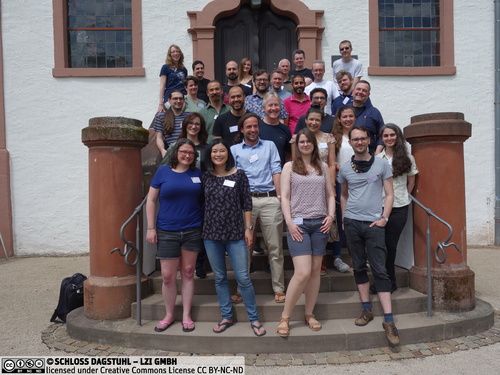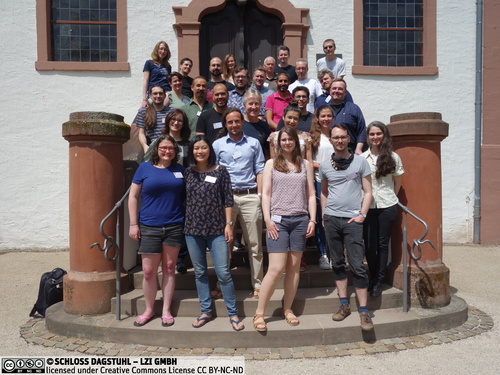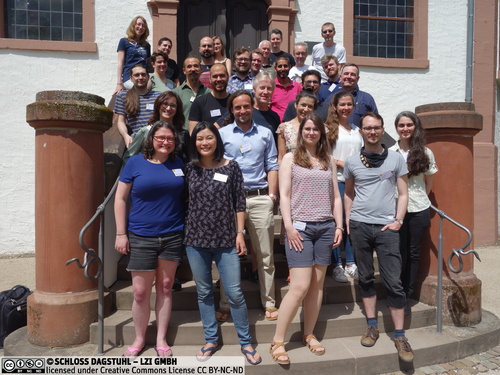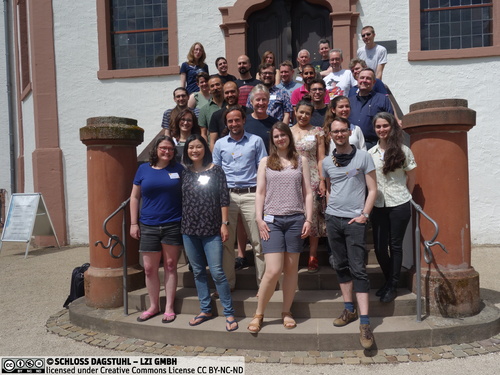Dagstuhl Seminar 22251
Human-Game AI Interaction
( Jun 19 – Jun 24, 2022 )
Permalink
Organizers
- Dan Ashlock (in memoriam; † April 5, 2022)
- Setareh Maghsudi (Universität Tübingen, DE)
- Diego Perez Liebana (Queen Mary University of London, GB)
- Pieter Spronck (Tilburg University, NL)
Contact
- Marsha Kleinbauer (for scientific matters)
- Simone Schilke (for administrative matters)
Impacts
- The Challenge of Evaluating Player Experience in Tabletop Role-Playing Games : article in FDG '23 : Proceedings of the 18th International Conference on the Foundations of Digital Games - Liapis, Antonios; Denisova, Alena - New York : ACM, 2023. - 10 pp..
- Designing for Playfulness in Human-AI Authoring Tools : article in FDG '23: Proceedings of the 18th International Conference on the Foundations of Digital Games - Liapis, Antonios; Guckelsberger, Christian; Zhu, Jichen; Harteveld, Casper; Kriglstein, Simone - New York : ACM, 2023. - 4 pp..
Schedule
Over the past decades, artificial intelligence has evolved from esoteric techniques used mainly in computer science research to an integral and ever-growing part of the daily lives of most humans. People regularly interact with semi-intelligent machines during their daily lives, whether it is via smartphone applications, embedded systems in cars and household electronics, client support systems, or helpful technology installed on personal computers. People wish and expect systems to respond intelligently to their requests, and even to anticipate their actions. While improvements to the interaction between humans and intelligent systems in this respect have been made over the years, there is still a long way to go before these systems exhibit a level of understanding and intuition which can be expected from a human partner.
Human-computer interfaces (HCI) are a well-established scientific research domain. We noted that HCI research generally neglects the use of artificial intelligence as a integral part of an interface. Almost any person that uses computers can quickly recall multiple frustrating interactions with the current state of the art in artificial intelligence in interfaces. Since annoyance and apparent incompetence can derail the adoption of otherwise promising and potentially transformative technology, research into improving interfaces using AI is timely.
An AI assistant is broadly recognized as being a key factor in increasing human productivity, but it must be an AI assistant that the user either enjoys working with or that the user barely notices, not one that must be bludgeoned into useful behavior or constantly fought with. Perfection of assistants, companions, and even opponents that correctly anticipate and collaborate in the relatively controlled domain of games provides a smooth path to such developments in broader contexts.
We argue that virtual worlds, as found in computer games, are an ideal environment in which to experiment with the interaction between humans and artificial intelligence. There are at least three reasons for this. First, virtual worlds often approach the complexity of the "real world", while still being under the control of the researcher and completely observable. Second, the agents in virtual worlds are supposed to represent "real people" and are approached as such by the humans who "play" with the virtual world. Third, the potential interactions that players have with the virtual worlds are highly diverse and wide-ranging, which presents a substantial challenge for artificial intelligence to respond to in a reasonable fashion.
In recent years, the number of ways in which human players can interact with games have increased considerably. While ten years ago interaction was almost exclusively through mouse and keyboard or controllers, nowadays games can potentially respond to natural movements and facial expressions captured by a camera, to spoken language, to eye movements, and to signals captured by a variety of sensors. Brain-computer interface (BCI) technology has become more mainstream, offering possibilities for games to respond to a users' brain activity. Using VR technology, games can respond to movements of players in natural space. AI that can use all these interface elements to make game agents a natural and appreciated partner or opponent for humans can form the basis for advanced AI agents that interact with humans not only in games, but also in the real world.
The research area in which the proposed seminar is rooted is the interaction between humans and game AI, aiming for natural and appropriate responses of computational agents in virtual worlds to human behavior, making use of both traditional interaction technology as well as modern sensor and interaction technology.
The research area lends itself for a wide range of research topics. For the preparation of this seminar, we proposed the following set of sub-topics:
- Personalized Human-Game AI Interaction: Humans have different backgrounds, interests, and goals. As such, there is no "one-size-fits-all" interference and interaction form. Under this topic, we explore game adaptation as a type of automatic game design. The goal is to permit the AI to adapt the game environment to the player based on the observed features and received feedback. Instead of fully automatic game design, a sophisticated game design leaves scope for an AI to adapt to a broad variety of players. Such personalized adaptation could be extended to adaptation of the actual game interface -- in games, usually complex interactions are possible, which novice players are not capable of employing. Therefore, automatically adapting the interface to the observed experience level of the player may be a valid approach to effective personalization.
- Human-Game AI Interaction for People with Disabilities: People with disabilities require special attention when designing interfaces, to mitigate adverse effects of disabilities, so that a suitable experience is ensured for everyone. Game AI can potentially help to diagnose disabilities, both physically and psychologically. There is also the potential for game AI to create awareness of issues faced by those with disabilities, by intelligently adapting the interface in such a way that the player experiences it as a person with disabilities would.
- Multimodal Interfacing and Interaction: Multimodal systems offer a flexible and efficient interaction environment that consists of several input/output possibilities including text, speech, and vision. How to effectively use these possibilities in game design is still an open problem. A compelling application of artificial intelligence is to rapidly learn which modes a given player finds natural and enjoyable. The type of interface a user is comfortable with is likely to cross boundaries between different applications, meaning that an "interface fingerprint" may be derivable that can be carried with the user, permitting the re-use of information gained.
- Enhancing Human Creativity with Artificial Intelligence: Computational Creativity is a field of AI where automatic AI systems design and create various forms of art, which may include images, drawings, poetry and music. In the broader sense, these systems create new content either completely by themselves, or with the human providing input at specific points. Research into this fusion of the creative skills of humans and AI systems would move the state of the art a step forward: from being inferior content creators the AI systems would become a tool for amplifying and augmenting the superior creative abilities of a human being, in a bi-directional collaboration process. AI systems should be able to learn from the human, anticipate what they intend to do, and understand the domain of discourse. They would provide advice on content creation and help when the user struggles with certain techniques or creative methods. By learning the skills of the human, AI systems would be able to propose alternatives that lie outside their expertise, allowing the humans to learn, refine and improve their capabilities. The users would experience a system that adapts to their skills, needs and pace, and becomes a personalized companion in their learning process.
- Trustful and Reliable Human-Game AI Interaction: We often observe that humans feel uncomfortable with AI recommendations. Moreover, mistakes made by humans are deemed more tolerable than those made by an AI. While there is no objective rationale for this difference, it is hard to justify the use of AI for humans by arguing that AI offers a lower mistake probability compared to humans. It is therefore imperative to find new ways to convince humans to interact with the game AI and to take its advice seriously. Moreover, it is crucial to minimize any effect that might harm such trust, regardless of its origin.
- Information Flow in Human-Game AI Interaction: A game AI must observe the human player and, in turn, provide players with information that they find helpful, valuable, or interesting. Even the most potentially helpful information is not actually helpful if the player cannot understand it or if it is not useful to their particular style of play. The flow of information is particularly important between the human player and an AI companion. Reliable metrics that ascertain if the human uses information offered by the AI, that check if the AI fails to provide information that the human tries to find in other ways, and assessment of defects in the human's play that suggest which information is needed, are potential goals of research in this area.
- Believable Human-Game AI Interaction: In the last decade, contests have been held at several conferences where human judges voted on the "humanity" of both human game players and AI players in an effort to score the ability of the AI players to behave in a plausibly human manner. Attempts to make AIs interact in a way that is indistinguishable from human interaction are a natural way to structure research into human-game AI interaction. We note that the believability of game AI often suffers because it fails to recognize that it misunderstands the human player, or that the human player misunderstands the AI. How to recognize misunderstanding, followed by how to correct for misunderstanding, are important steps in making game AI more believable.
- Ethics of Human-Game AI Interaction: Several of the aforementioned research directions rely heavily on big data analysis. Acquiring such a massive amount of data is a challenging task. Perfect anonymization is hard to achieve, and often undesirable as multiple parties are involved in data collection and integration. To what extent is it ethical to collect personal interaction information? Are there ethical restrictions to the extent to which an AI is allowed to analyze a player's personality and demographics? These questions need answering even if a player gives permission to collect and use such data.
- Novel Forms of Interaction and Interfaces in Game AI: New technology gives rise to new possibilities in game interaction and interfacing. While developers often try to restrict themselves to small adaptations in tried-and-true forms of interaction, it makes sense to consider the interaction possibilities originating with novel technology, such as virtual reality and brain-computer interfacing. Beyond those, there may be ways for humans and AI to interact with each other that has not yet been imagined, or which can benefit from re-imagining. Player-AI interaction can be implemented in many forms, such as (1) cuing a player with environmental information from music to decor, (2) influencing a player by adjusting game elements such as local architecture, opponents, and rewards, and (3) making a player respond to the social tone of non-player characters. Such alternate forms of player-AI interaction warrant investigation.
This seminar was organized around workgroups, which worked in teams and topics proposed by the participants of the seminar in the areas outlined above. These workgroups were accompanied by plenary sessions for group formation, topic debate and discussions of the deliberation of each group. Workgroups were dynamic, so participants could move between them, and new groups were formed during the week. A Discord server was setup for coordination and announcements, and it was also used by the different groups for document and link sharing. This also has the benefit of providing a place for discussions after the seminar, easing the communication and further work among the members of each workgroup.
It is worthwhile mentioning the work carried out during the invitation process. Due to the COVID crisis, the changes in the political landscape, and the war in Ukraine, many declined the invitation, and many participants dropped out after originally having accepted the invitation. Thus, multiple rounds of invitations were run until two weeks before the seminar. We invited close to 100 people, the full list of invitations having a high diversity (a 50\% male-female split, about half invitations for 'junior' people, and invitees hailing from all continents - including South America and Africa, which are usually highly underrepresented). In the end, just over 30 participants attended the seminar (out of the 45 possible). Size-wise this was a slight disappointment. We were fortunate, however, that those that did attend were highly enthusiastic and highly knowledgeable about the topics covered, which made the seminar a great success.
 Pieter Spronck, Daniel Ashlock, Setareh Maghsudi, and Diego Perez Liebana
Pieter Spronck, Daniel Ashlock, Setareh Maghsudi, and Diego Perez Liebana
Over the past decades, artificial intelligence has evolved from esoteric techniques used mainly in computer science research to an integral and ever-growing part of the daily lives of most humans. People wish and expect systems to respond intelligently to their requests, and even to anticipate their actions. Since annoyance and apparent incompetence of computer systems can derail the adoption of otherwise promising and potentially transformative technology, research into improving interfaces using AI is timely. Of particular interest in this respect are AI assistants, which are broadly recognized as a key factor in increasing human productivity.
Virtual worlds, as found in computer games, are an ideal environment in which to experiment with the interaction between humans and artificial intelligence for at least three reasons: (1) they are reminiscent of the “real world,” (2) they often contain agents which represent “real people,” and (3) they offer a wide and highly diverse range of challenging interaction possibilities. In recent years, the number of ways in which human players can interact with games have increased considerably, using not only mouse and keyboard, but also cameras to capture natural movements and facial expressions, microphones to record spoken language, and sensors to register eye movements and a variety of physiological signals.
The research area in which the seminar is rooted is the interaction between humans and game AI, aiming for natural and appropriate responses of game agents to human behavior, making use of both traditional interaction technology and modern sensor and interaction technology. The research area lends itself to a wide range of research topics. We aim to focus on the following:
- Personalized Human-Game AI Interaction
- Human-Game AI Interaction for People with Disabilities
- Multimodal Interfacing and Interaction
- Enhancing Human Creativity with Artificial Intelligence
- Trustful and Reliable Human-Game AI Interaction
- Information Flow in Human-Game AI Interaction
- Believable Human-Game AI Interaction
- Ethics of Human-Game AI Interaction
- Novel Forms of Interaction and Interfaces in Game AI
The Dagstuhl Seminar will bring together computer scientists, cognitive scientists, and industry experts with the common goals of gaining a deeper understanding of human-game AI interaction, in particular in using AI in to make the interaction between humans and game agents more natural. During the seminar we will not only have theoretical discussions, but also spend part of the seminar on trying to achieve practical results, leading to prototypes which demonstrate ideas for new research directions.
This seminar is the fifth in a series of Dagstuhl Seminars focusing on Computational and Artificial Intelligence in Games. The previous seminars in the series were met with great enthusiasm and led to strong follow-ups. The seminars are seen in the Game AI research domain as highly influential in developing new ideas and creating new collaborations. For newcomers in the research domain these seminars are an ideal way to get integrated into the research community.
 Dan Ashlock, Setareh Maghsudi, Diego Perez Liebana, and Pieter Spronck
Dan Ashlock, Setareh Maghsudi, Diego Perez Liebana, and Pieter Spronck
- Maren Awiszus (Leibniz Universität Hannover, DE) [dblp]
- Cameron Browne (Maastricht University, NL) [dblp]
- Duygu Cakmak (Creative Assembly - Horsham, GB) [dblp]
- Alex J. Champandard (creative.ai - Wien, AT) [dblp]
- Guillaume Chanel (University of Geneva, CH) [dblp]
- Michael Cook (Queen Mary University of London, GB) [dblp]
- Alena Denisova (University of York, GB) [dblp]
- Alexander Dockhorn (Leibniz Universität Hannover, DE) [dblp]
- Manuel Eberhardinger (Hochschule der Medien - Stuttgart, DE) [dblp]
- Jakob Foerster (University of Oxford, GB) [dblp]
- Casper Harteveld (Northeastern University - Boston, US) [dblp]
- Amy K. Hoover (New Jersey Institute of Technology (NJIT) - Newark, US) [dblp]
- Ahmed Khalifa (University of Malta - Msida, MT) [dblp]
- Antonios Liapis (University of Malta - Msida, MT) [dblp]
- Daniele Loiacono (Polytechnic University of Milan, IT) [dblp]
- Simon M. Lucas (Queen Mary University of London, GB) [dblp]
- Setareh Maghsudi (Universität Tübingen, DE) [dblp]
- Ana Matran-Fernandez (University of Essex - Colchester, GB) [dblp]
- Paris Mavromoustakos Blom (Tilburg University, NL) [dblp]
- Mark J. Nelson (American University - Washington, US) [dblp]
- Mirjam Palosaari Eladhari (Södertörn University - Huddinge, SE) [dblp]
- Diego Perez Liebana (Queen Mary University of London, GB) [dblp]
- Mike Preuß (Leiden University, NL) [dblp]
- Lisa Rombout (Tilburg University, NL) [dblp]
- Jacob Schrum (Southwestern University - Georgetown, US) [dblp]
- Pieter Spronck (Tilburg University, NL) [dblp]
- Tommy Thompson (AI and Games - London, GB) [dblp]
- Remco Veltkamp (Utrecht University, NL) [dblp]
- Vanessa Volz (modl.ai - Copenhagen, DK) [dblp]
- Jichen Zhu (IT University of Copenhagen, DK) [dblp]
Related Seminars
- Dagstuhl Seminar 12191: Artificial and Computational Intelligence in Games (2012-05-06 - 2012-05-11) (Details)
- Dagstuhl Seminar 15051: Artificial and Computational Intelligence in Games: Integration (2015-01-25 - 2015-01-30) (Details)
- Dagstuhl Seminar 17471: Artificial and Computational Intelligence in Games: AI-Driven Game Design (2017-11-19 - 2017-11-24) (Details)
- Dagstuhl Seminar 19511: Artificial and Computational Intelligence in Games: Revolutions in Computational Game AI (2019-12-15 - 2019-12-20) (Details)
- Dagstuhl Seminar 24261: Computational Creativity for Game Development (2024-06-23 - 2024-06-28) (Details)
- Dagstuhl Seminar 27091: Transferability of Game AI (2027-02-28 - 2027-03-05) (Details)
Classification
- Artificial Intelligence
- Human-Computer Interaction
- Multimedia
Keywords
- computational intelligence
- artificial intelligence
- games
- modeling
- interaction





 Creative Commons BY 4.0
Creative Commons BY 4.0
